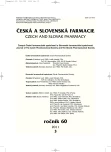Inhibiční aktivita vybraných ß-karbolínových alkaloidů na enzymy acetylcholinesterasu a butyrylcholinesterasu
Autoři:
Zuzana Kršková; Jan Martin; Jaroslav Dušek
Působiště autorů:
Department of Pharmacognosy, Charles University in Prague, Faculty of Pharmacy in Hradec Králové, Czech Republic
Vyšlo v časopise:
Čes. slov. Farm., 2011; 60, 125-131
Kategorie:
Původní práce
Souhrn
Tato práce se zabývá testováním inhibiční aktivity ß-karbolínových alkaloidů na aktivitu enzymů acetylcholinesterasy (ACHE) a butyrylcholinesterasy (BUCHE) s použitím „Fast Blue B salt“ testu na TLC desce a Ellmanova testu provedeném na spektrofotometru. Také bylo zkoumáno, jak dimethylsulfoxid (DMSO), který byl použit ve směsi s vodou jako rozpouštědlo, ovlivňuje aktivitu enzymů a alkaloidů. Z výsledků vyplývá, že nejvyšší inhibiční aktivitu na ACHE má s použitím eserinu jako referenční látky harmin ve formě báze i soli, a to jak v prostředí vodném, tak i ve směsi DMSO s vodou. Nejvyšší inhibiční aktivitu na BUCHE vykazuje ve vodném prostředí harmalol ve formě soli, ve směsi DMSO s vodou je nejaktivnější harmin ve formě báze i soli. Ukázalo se, že DMSO značně ovlivňuje nejen aktivitu enzymů, ale také alkaloidů.
Klíčová slova:
ß-karbolínové alkaloidy – ACHE – BUCHE – DMSO – Ellmanův test – test „Fast Blue B salt“
Zdroje
1. Schott, Y. et al.: 6-Hydroxy- and 6-methoxy-ß-carbolines as acetyl- and butyrylcholinesterase inhibitors. Bioorg. Med. Chem. Lett. 2006; 16, 5840–5843.
2. Kamal, M. A. et al.: Kinetic analysis of the inhibition of human butyrylcholinesterase with cymserine. Biochim. Biophys. Act. 2006; 1760, 200–206.
3. Höschl, C. a kol.: Symposium 1 „Alzheimerova choroba“. Praha: Galén 1999; 10 s.
4. Allen, J. R. F., Holmested, B. R.: The simple ß‑carboline alkaloids. Phytochemistry 1980; 19, 1573-1582.
5. Adachi, J. et al.: Determination of ß-carbolines in foodstuffs by high-performance liquid chromatography and high-performance liquid chromatography – mass spectrometry. J. Chromat. A 1991; 538, 331–339.
6. Gross, G. A. et al.: Heterocyclic aromatic amine formation in grilled bacon, beef and fish and in grill scrapings. Carcinogenesis 1993; 14, 2313–2318.
7. Herraiz, T., Huang, Z. and Ough, C. S.: 1,2,3,4--Tetrahydro-ß-carboline-3-carboxylic acid and 1-methyl-1,2,3,4-tetrahydro-ß-carboline-3-carboxylic acid in wines. J. Agric. Food Chem. 1993; 41, 455–459.
8. Totsuka, Y. et al.: Quantification of the co-mutagenic ß-carbolines, norharman and harman, in cigarette smoke condensates and cooked fous. Cancer Lett. 1999; 143, 139–143.
9. Zheng, W. et al.: Determination of Harmane and Harmine in Human Blood Using Reversed-Phased High-Performance Liquid Chromatography and Fluorescence Detection. Anal. Biochem. 2000; 279, 125-–129.
10. May, T. et al.: Comparison of the in vitro binding characteristics of the ß-carbolines harman and norharman in rat brain and liver and in bovine adrenal medulla. Arch. Pharmacol. 1994; 349, 308–317.
11. Moura, D. J. et al.: Antioxidant properties of ß-carboline alkaloids are related to their antimutagenic and antigenotoxic activities. Mutagenesis 2007; 22, 293–302.
12. Jiménez, J. et al.: Cytotoxicity of the ß-carboline alkaloids harmine and harmaline in human cell assays in vitro. Experiment. Toxicol. Pathol. 2008; 60, 381–389.
13. Freedland, C. S. and Mansbach, R. S.: Behavioral profile of constituents in ayahuasca, an Amazonian psychoactive plant mixture. Drug Alcohol Depend. 1999; 54, 183–194.
14. Boeira, J. M. et al.: Genotoxic and recombinogenic activities of the two ß-carboline alkaloids harman and harmine in Saccharomyces cervisie. Mutat. Res. 2002; 500, 39–48.
15. Glennon, R. A. et al.: Binding of ß-carbolines and related agents at serotonin (5-HT2 and 5-HT1A), dopamine (D2) and benzodiazepine receptors. Drug and Alcohol Depend. 2000; 60, 121–132.
16. Martson, A., Kissling, J. and Hostettmann, K.: A rapid TLC bioautographic method for the detection of acetylcholinesterase and butyrylcholinesterase inhibitors in plants. Phytochem. Anal. 2002; 13, 51–54.
17. Nino, J. et al.: In vitro inhibition of acetylcholinesterase by crude plant extracts from Colombian flora. Mem. Inst. Oswaldo Cruz 2006; 101, 783–785.
18. Darvesh, S. et al.: Differential effects of lipid-lowering agents on human cholinesterases. Clin. Biochem. 2004; 37, 42–49.
19. Composite authors: Československý lékopis 4, Praha: Avicenum 1987, 360 s., 370 s.
20. Di Giovanni, S. et al.: In vitro screening assays to identify natural or synthetic acetylcholinesterase inhibitors: Thin layer chromatography versus microplate methods. Eur. J. Pharmacol. Sci. 2008; 33, 109–119.
21. Lima, M. M. C. et al.: Acetylcholinesterase Activity of Alkaloids from the Leaves of Waltheria brachypetala. Planta Med. 2009; 75, 335–337.
22. Ma, X. and Gang, D. R.: The Lycopodium alkaloids. Nat. Prod. Rep. 2004; 21, 752–772.
23. Skup, M., Oderfeld-Nowak, B., Rommelspacher, H.: In Vitro Studies on the Effect of ß-Carbolines on the Activities of Acetylcholinesterase and Choline Acetyltransferase and on the Muscarinic Receptor Binding of the Rat Brain. J. Neurochem. 1983; 41, 62–68.
Štítky
Farmacie FarmakologieČlánek vyšel v časopise
Česká a slovenská farmacie

2011 Číslo 3
- Přerušovaný půst může mít významná zdravotní rizika
- Top zaměstnavatelé ve zdravotnictví si hýčkají už studenty
- Mikroplasty a jejich riziko pro zdraví: Co všechno víme?
Nejčtenější v tomto čísle
- Význam genetického polymorfizmu enzýmov cytochrómu P450 – časť I.Enzýmový systém cytochrómu P450 a cytochróm P450 1A2
- doc. RNDr. Eva Račanská, CSc. – laureátka Weberovej ceny SFS
- Vplyv membrán na permeáciu alaptidu z hydrogélov
- Farmaceutické aspekty živočíšnej lipoxygenázy
